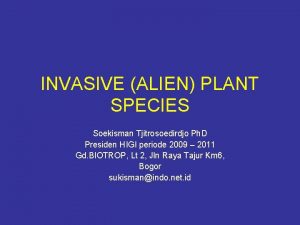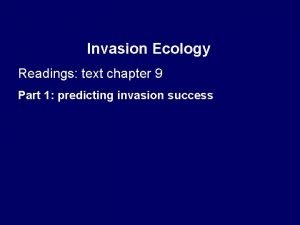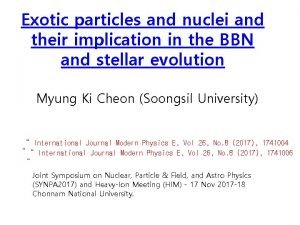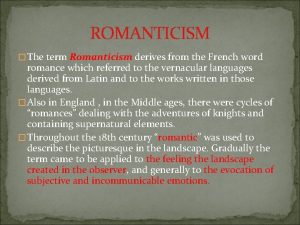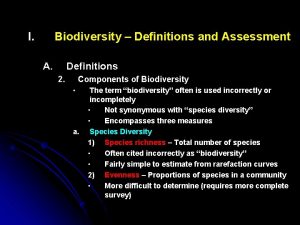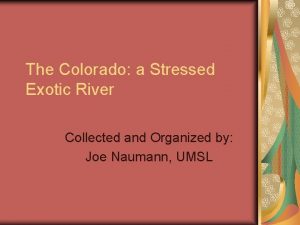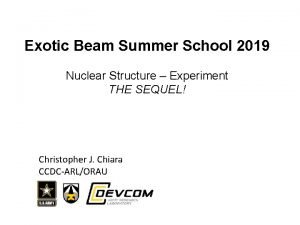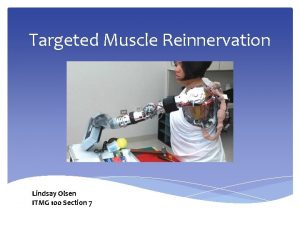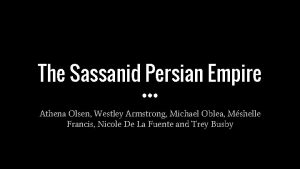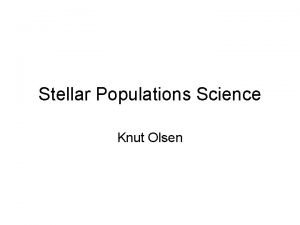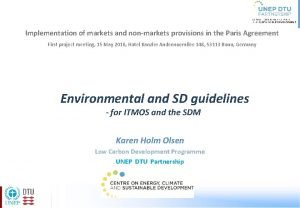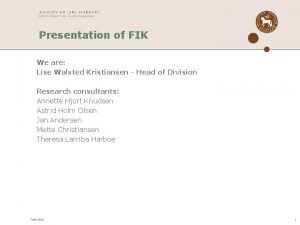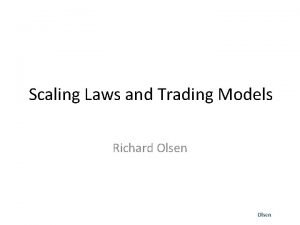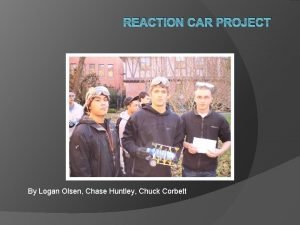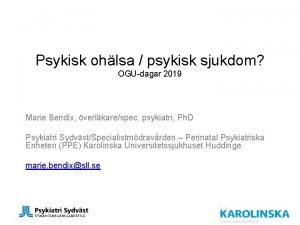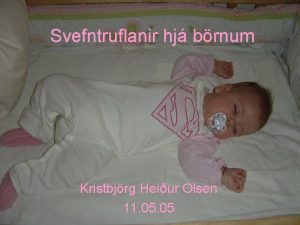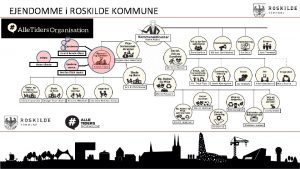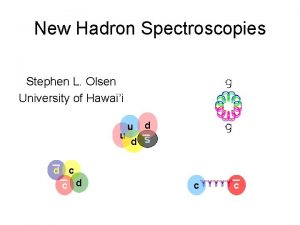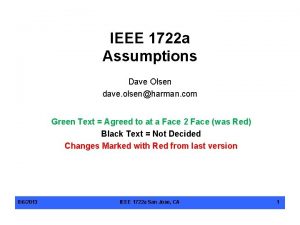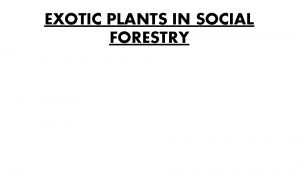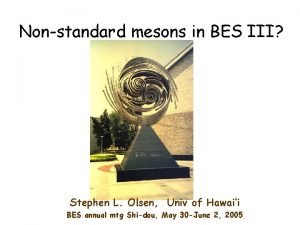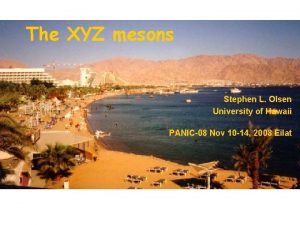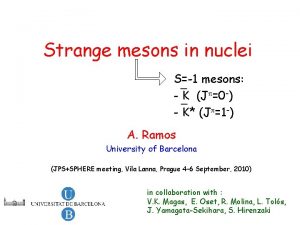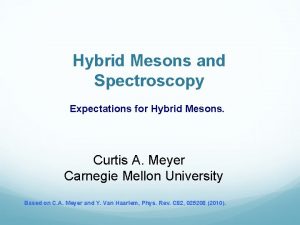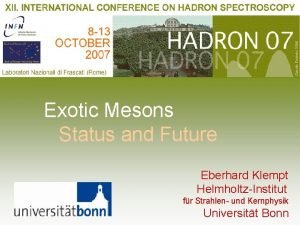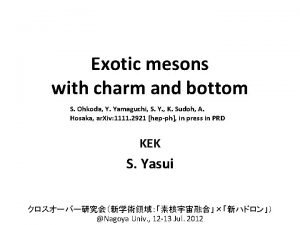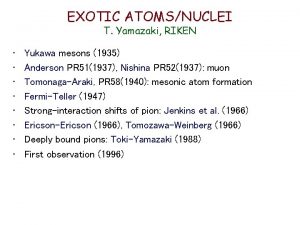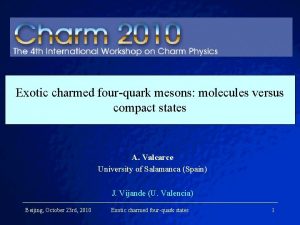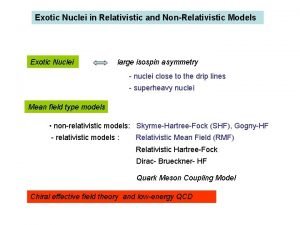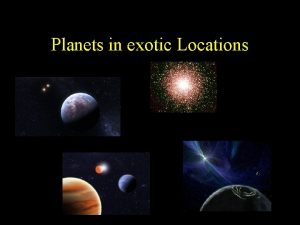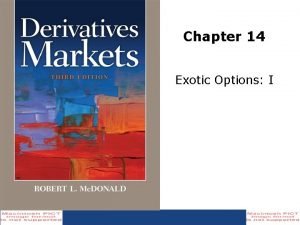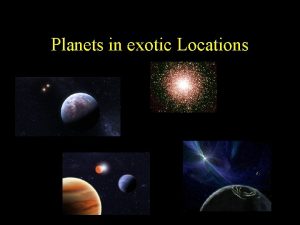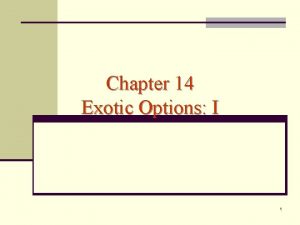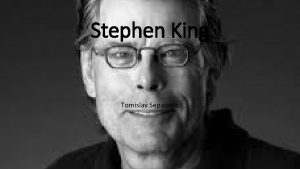Evidence for Exotic Mesons Stephen Olsen U of




























































- Slides: 60

Evidence for Exotic Mesons Stephen Olsen U. of Hawai’i & 高能所 北京 Ba. Bar Belle Workshop on light flavors & chiral dynamics 北大 Sept 29 -30, 2007

Y(4325) Y(4660) X(4160 ) Y(3940) Y(4780) Z(4430) Y(4260) Y(4008) X(3940) X(3872) Talk outline

Constituent Quark Model (CQM) Gell-Mann (& 6 antiquarks) 6 quarks u+2/3 c+2/3 t+2/3 d-1/3 s-1/3 b-1/3 Baryons: qqq Wc : c+2/3 s+1/3 s-1/3 C-2/3 S=1/3 s+1/3 u-2/3 c-2/3 d+1/3 t-2/3 +1/3 s+1/3 b Mesons: q q u+2/3 + B : b+1//3 B- : u-2/3 b-1/3 Zweig

Fabulously successful mesons q q

QCD suggests non-qq meson spectroscopies Glueballs: gluon-gluon color singlet states Multi-quark mesons: molecules: d c diquark-antidiquark: c d qq-gluon hybrid mesons c c d

Searching for non-QPM hadrons is a risky business

forget Remember the pentaquark Q+(1530)? T. Nakano et al (LEPS) PRL 91 012002 (2003) 742 citations

You never can be sure: Is mother nature is smiling at you? or something else.

The XYZ mesons: candidates for non-qq states 4 quark candidates (from Belle) u c c “hybrid” qq-gluon candidates (from Babar & Belle)

Charmonium is of particular interest because it is an especially good system to use to search for non-qq mesons

a cc meson has to fit into one of these slots: If it doesn’t, it is a good candidate for a non qq meson

B-factories produce lots of cc pairs 0 -+, 1 - - or 1++ 0 -+, 0++, 2++ 1 - - only C =+ states

Lots new on the “XYZ” particles Status spring 2007: New Belle/Ba. Bar results: (Summer 2007) • X(3872) – + - J/ in B K + -J/ X(3880) DD • Z(3930) - e+e- J/ DD – DD in gg DD • Y(3940) – w. J/ in B K w. J/ confirmed by Ba. Bar updated by Belle • X(3940) – e+e- J/ X & e+e- J/ DD* Y(4008)? X(4160) D*D* • Y(4260) – + -J/ in e+e- g + - J/ • Y(4325) – - e+e- J/ D*D* Y(4250) Y(4370) + - ’ in e+e- g + - ’ Z+(4430) + Y(4660) - B K + ’

I’ll concentrate on recent results.

X(3872) >300 citations

X(3872) properties (PDG 2007) Me. V MD 0 + MD*0 = 3. 871. 8 ± 0. 4

M( ) looks like r CDF Belle c 2/dof = 43/39 (CL=28%) PRL 96 102002 kinematic limit≈mr • Belle & CDF: JPC = 1++ most likely

What’s new with the X(3872)? Ba. Bar confirms Belle’s DD threshold enhancement Both groups see a high mass value Mass is 3. 8± 1. 2 Me. V above WAvg X(3872) J/ mass; (~3 ) is this significant?

Belle’s B KSX & B K±X comparison Confirms an earlier Ba. Bar result KS mode DM = 0. 22 ± 0. 90 ± 0. 27 Me. V K± mode “molecular” models predicted this to be <<1 (Braaten et al PRD 71 074005) “diquark-antidiquark” models predicted this to be 8± 3 Me. V (Maiani et al PRD 71 014028)

Is there a cc slot for the X(3872)? 3872 1++ (cc 1’) §Br(g. J/ ) too small §Br(r. J/ ) too big 2 -+(hc 2) § hc 2 r. J/ ispin forbidden § D 0 D 0 0 @ thresh. suppressed § B Kcc(J=2) suppressed

Y(3940) in B K w. J/ Belle PRL 94, 182002 (2005) M 2(w. J/ ) Ge. V 2 M≈3940 ± 11 Me. V G≈ 92 ± 24 Me. V M 2(Kw) Ge. V 2 M(w. J/ ) Me. V

Y(3940) properties G(Y 3940 w. J/ ) >~ 7 Me. V (an SUF(3) violating decay) this is 103 x G( ’ h. J/ ) (another SUF(3) violating decay) M(w. J/ ) Me. V Belle PRL 94, 182002 (2005) if the Z(3930) is the cc 2’ the Y(3940) mass is too high for it to be the cc 1’

Confirmed by Ba. Bar this summer G. Cibinetto EPS-2007 B± K±w. J/ B 0 KSw. J/ M 2(Kw) ratio M(w. J/ ) Some discrepancy in M & G; general features agree

Is there a cc slot for Y(3940) ? 3940 3931 hc ” Mass is low cc 1’ Can M(cc 1’)>M(cc 2’)? cc 0’ “ “ For any charmonium assignment, G[Y(3940) w J/ ] is too large.

Belle updates e+e- J/ D(*) Use “partial reconstruction technique” J/ reconstruct these - e e m ion u u lat n ti ihi n n Co an + e+ e- D( *) “Recoil” D(*) undetected (inferred from kinematics)

J/ D(*) recoil mass Belle ar. Xiv: 0708. 3812 J/ DD* J/ DD Partial reconstruction J/ D*D* J/ DD* reconstruct

M(DD*): Confirm X(3940) DD* D-reconstructed D*-tag 6. 0 M = 3942 Gtot = 37 D sidebands Nsig =52 +7 -6 ± 6 Me. V +26 -15 +24 -16 ± 12 Me. V ± 11 evts ar. Xiv: 0708. 3812 Bg subtracted Previous values: M = (3943 ± 6) Me. V G = (15. 4 10. 1) Me. V G < 52 Me. V at 90%CL PRL 98, 802001 (2007)

Is there a cc slot for X(3940) ? hc ” 3940 3931 cc 1’ cc 0’ Mass is ~ 60 Me. V low (if (3 S) = (4040)) Mass is > M(cc 2’) & no cc 1 recoil seen Mass is > M(cc 2’) & DD decays not seen Maybe the hc ”

M(DD): Broad threshold enhancement D-reconstructed D-tag Relativistic BW D sidebands Bg subtracted 3. 8 ar. Xiv: 0708. 3812 Resonance? Thresh effect? … ?

M(D*D*) a new state at ~4160 Me. V D*-reconstructed + D*tag 5. 5 M = 4156 +25 -20 Gtot = 139 +111 -61 Nsig =24 +12 -8 ± 15 Me. V ± 21 Me. V ± 11 evts ar. Xiv: 0708. 3812 if 0 ++ not , why i see n in s it DD It has to have C=+; most likely 0 -+, . . . possibly 0++

A cc assignment for X(4160) ? Mass is too high (if (3 S)= (4040)) hc ” 3940 3931 or too low (if (3 S) = (4160)) hc’’’ Mass is far too low (unless (4 S)= (4160), but, then, where is (2 D? )) Can place either the X(3940) or X(4160), but probably not both.

The -1 states seen in ISR

+ e e gisr Y(4260) at Ba. Bar PRL 95, 142001 (2005) fitted values: M=4259 8 G = 88 23 233 fb-1 Y(4260) ~50 pb +2 -6 +6 -9 Me. V

Not seen in + e e hadrons ~3 nb 4260 peak(Y(4260) + -J/ )~50 pb m iu on 4260 rm a ch rds BES data y b nda e g sta Hu G(Y 4260 + - J/ ) > 1. 6 Me. V @ 90% CL X. H. Mo et al, PL B 640, 182 (2006)

“Y(4260)” at Belle M=4247 12 +17 -32 Me. V G = 108 19 ± 10 Me. V M=4008 40 +114 -28 (New) Ba. Bar values: M=4259 8 G = 88 23 +2 -6 +6 -9 Me. V G = 226 44 ± 87 Me. V ? ? ? Resonance? Thresh effect? …? C. Z Yuan et al (Belle) ar. Xiv: 0707. 2541 To appear in PRL

M( ) near 4008 & 4260 Me. V 3. 8 < M( J/ ) <4. 2 Ge. V 4. 2 < M( J/ ) <4. 4 Ge. V

No 1 -- cc slot for the Y(4260) X. H. Mo et al, hep-ex/0603024 4260 4280

! Is the Y(4260) a cc-gluon hybrid? ! ! e s e c c th f o l • qq-gluon excitations predicted 30 yrs ago l a h c • lowest 1 cc-gluon mass expected at ~4. 3 Ge. V t a m o • relevant open charm tthreshold is D**D (~4. 28 Ge. V) s m e than that for normal charmonium • G( J/ ) larger e s ) 0 • G(e e )6 smaller than that for ordinary charmonium 2 4 ( Y Horn & Mandula PRD 17, 898 (1977) -- Banner et al, PRD 56, 7039 (1997); Mei & Luo, IJMPA 18, 15713 (2003) Isgur, Koloski & Paton PRL 54, 869 (1985) Mc. Neile, Michael & Pennanen PRD 65, 094505 (2002) + - Close & Page NP B 443, 233 (1995)

D** spectrum D 1 D D 2 D DD** thresholds in & “Y(4260)” No obvious distortions 4. 28 -m. D M( + -J/ ) Ge. V

D 1 D D D 2 Ba. Bar + - ’ peak at 4325 Me. V e+e- g. ISR + - ’ 298 fb-1 (Ba. Bar) hep-ex/0610057 Nevt = 68 (<5. 7 Ge. V/c 2) Nbkg = 3. 1 1. 0 M=4324 24 Me. V G = 172 33 Me. V above all D**D thresholds Not Compatible with the Y(4260) Ba. Bar PRL 98 252001 (2007) S. W. Ye QWG-2006 June 2006 2 -prob Y(4260) (4415) < 5. 7 Ge. V/c 2 6. 5 10 -3 1. 2 10 -13 Y(4320) 29%

4325 Me. V + - ’ peak in Belle Two peaks! M=4361 9 ± 9 Me. V G = 74 15 ± 10 Me. V 4260 (new) (both relatively narrow) (& both above D**D thresh) (& neither consistent with 4260) M=4664 11 ± 5 Me. V G = 48 15 ± 3 Me. V Ba. Bar values M=4324 24 Me. V G = 172 33 Me. V X. L. Wang et al (Belle) ar. Xiv: 0707. 3699 548 fb-1

Y(4660) f 0(980) ’? 4. 0 < M( ’) <4. 5 Ge. V 4. 5 < M( ’) <4. 9 Ge. V f 0(980)?

K+K- J/ from Belle (very new) M=4430 G = 254 +38 -43 +55 -46 Me. V (4415)? M=4875 132 Me. V G = 630 126 Me. V 4260 C. Z. Yuan et al (Belle) ar. Xiv: 0709. 2565

M(K+K-)

Latest News lly a ric ed!! t ec arg l e h c

± M( ’) K* K Veto from B K KVeto 2* K ? ± ’ M = 4433 ± 4 ± 1 Me. V Gtot = 45 +17 +30 -13 -11 Me. V M 2( ’) Ge. V 2 Nsig =124 ± 31 evts 6. 5 M 2(K ) Ge. V 2 M( ’) Ge. V K. Abe et al (Belle) ar. Xiv: 0708. 1790

Could this be a reflection from the K channel?

Cos q vs M 2( ’) q ’ K +1. 0 22 Ge. V 2 (4. 43)2 Ge. V 2 0. 25 cosq M 2( ’) 16 Ge. V 2 M ( ’) & cosq are tightly correlated; a peak in cosq peak in M( ’) -1. 0

Can interference between K partial waves produce a peak? Only S-, P- and D-waves seen in data interfere Add incoherently

Can we make a peak at cosq ≈0. 25 with only S-, P- & D-waves? Not without introducing other, even more dramatic features at other cosq (&, , other M ’) values.

Comments on the Z+(4430) Not a reflection from the ~ K system No significant signal in B K J/ It has non-zero charge not cc or hybrid Mass, width & decay pattern similar to Y(4360) & Y(4660)

conclusions • • – – – • There seems to be a new hadron spectroscopy in the M=3. 5~5 Ge. V region Maybe more than one Bodes well for BESIII, Super-B factories & PANDA Some states are narrow even though they are far above decay thresholds e. g. Y(4660) ’ & Z+(4430) + ’ have large Q but G≈50 Me. V characterized by large partial widths (Bfs) to hadrons+J/ (or ’) – – – • (mine) – – Br(X(3872) r. J/ ) > 4. 3% (Isospin=1) G(Y(3940) w. J/ ) > 7 Me. V (SU(3) octet) G(Y(4260) + -J/ ) > 1. 6 Me. V States that decay to ’ not seen decaying to J/ (and vice-versa) Bf(Y(4660) ’) >> Bf(y(4660) J/ ) same for Y(4360) & Z(4430 ’ Y(4260) not seen in Y(4260) ’ • The new 1 -- states are not apparent in the e+e- D(*) cross sections • There is no evident transitions at the D**D mass threshold

New 1 -- states + - J/ + - ’ K+K- J/

DD thresholds DSDS thresholds some of the states are near thresholds, but this is not a universal feature

Y(4660) Y(4360) Y(4008) tot DD Y(4260) D*D* Pakhlova (Belle) PRL 98, 092001 (2007) DD* The 1 -- states do not match well to peaks in hadr. cross-sections

zz le ? Lots of pieces pu 0) 3 4 (4 e Z Y(3940) ) sa m 0 4 9 3 Ar e th Y(4360) ey Y(4260) ) 0 16 08) 4 ( X Y(40 al lf ro m Y(4660) th e X( X(3872)


Inclusive B Kx from Ba. Bar Fully reconstructed B- tags ?

M 2( ’) / cos q plot 1. 0< M(K )<1. 4 Ge. V Our attempts to fit the M=4. 43 Ge. V (cosq =0. 25) peak with any combination of S-, P- & D-waves

Ba. Bar looked for a charged partner of the X(3872) and excluded isospin 1: BF(B 0 X- K+ ) BF(X J/ψ - 0 ) < 5. 4 x 10 -6 BF(B- X- K 0 ) BF(X J/ψ - 0 ) < 2. 2 x 10 -5 c. f BF(B 0 X 0 K+ ) BF(X 0 J/ψ -- + ) =(1. 28 0. 41 ) x 10 -5
 Exotic species definition
Exotic species definition Exotic species definition
Exotic species definition Ferrari rental houston
Ferrari rental houston Exotic species definition
Exotic species definition Exotic species definition
Exotic species definition Exotic nucleosynthesis
Exotic nucleosynthesis Romsnticism
Romsnticism Woman walking in an exotic forest
Woman walking in an exotic forest Exotic species definition
Exotic species definition Exotic breeds of rabbits
Exotic breeds of rabbits Static hedging of exotic options
Static hedging of exotic options Advantages and disadvantages of shannon diversity index
Advantages and disadvantages of shannon diversity index Is the colorado river an exotic stream
Is the colorado river an exotic stream Exotic beam summer school
Exotic beam summer school Lindsay olsen singer
Lindsay olsen singer Athena olsen
Athena olsen Dylan knut olsen bokvist
Dylan knut olsen bokvist Olsen scale forex
Olsen scale forex Karen holm olsen
Karen holm olsen Riley olsen
Riley olsen Annette hjort olsen
Annette hjort olsen Olsen scale forex
Olsen scale forex Logan olsen
Logan olsen Marie bendix olsen
Marie bendix olsen Olsen restaurante argentina
Olsen restaurante argentina Run lola run script
Run lola run script Sassi uthsc
Sassi uthsc Olsen anorexie
Olsen anorexie Undergraduate research conference nyu
Undergraduate research conference nyu Tava olsen
Tava olsen Kristbjörg heiður olsen
Kristbjörg heiður olsen Tagudskiftning roskilde
Tagudskiftning roskilde Udsdc
Udsdc What is the theme of i stand here ironing
What is the theme of i stand here ironing Olsen assumption
Olsen assumption A pair of latex gloves was found at a crime scene
A pair of latex gloves was found at a crime scene Primary evidence vs secondary evidence
Primary evidence vs secondary evidence Fiber evidence can have probative value as class evidence.
Fiber evidence can have probative value as class evidence. Appeal to pity examples
Appeal to pity examples Secondary sources
Secondary sources Class vs individual evidence
Class vs individual evidence Primary evidence vs secondary evidence
Primary evidence vs secondary evidence Class evidence can have probative value
Class evidence can have probative value What is primary sources
What is primary sources Jobs vancouver
Jobs vancouver Strategi för svensk viltförvaltning
Strategi för svensk viltförvaltning Sura för anatom
Sura för anatom Variansen formel
Variansen formel Novell typiska drag
Novell typiska drag Tack för att ni har lyssnat
Tack för att ni har lyssnat Rutin för avvikelsehantering
Rutin för avvikelsehantering Läkarutlåtande för livränta
Läkarutlåtande för livränta Treserva lathund
Treserva lathund Tack för att ni lyssnade
Tack för att ni lyssnade Debattartikel struktur
Debattartikel struktur Påbyggnader för flakfordon
Påbyggnader för flakfordon Egg för emanuel
Egg för emanuel En lathund för arbete med kontinuitetshantering
En lathund för arbete med kontinuitetshantering Tobinskatten för och nackdelar
Tobinskatten för och nackdelar Tack för att ni har lyssnat
Tack för att ni har lyssnat Var finns arvsanlagen
Var finns arvsanlagen
